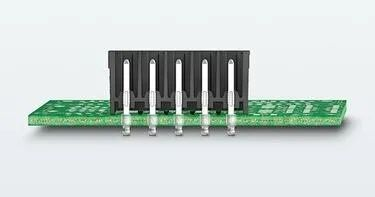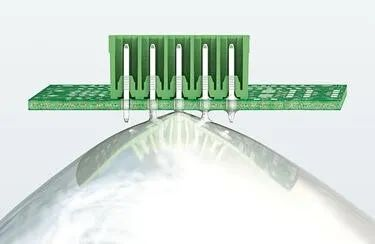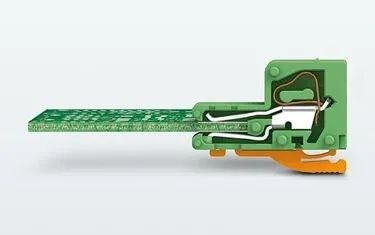Fixed connectors can easily and safely transmit signals, data and power to PCBs. This connection method is not only suitable for applications in many fields in various industries, but also can be used in Industry 4.0. Advanced PCB connection technology gives users the freedom to select the appropriate assembly type, supporting manual assembly as well as semi-automatic and fully automated manufacturing processes. This enables efficient assembly of PCBs and ensures process safety during processing.
SMT welding – an advanced welding process

Figure caption: SMT welding refers to welding structural parts to the top of the PCB
Surface mounting (surface mount technology – SMT) is the basis of modern component production. In contrast to through-hole assembly with wire structures, these surface mounted components (surface mount devices – SMD) have solderable connection surfaces and are soldered directly to the top of the PCB via a reflow soldering process. SMT soldering technology is not only low-cost but also enables high-quality PCB assembly, thus optimizing component production.
Reflow soldering – high mechanical stability for automated assembly

Figure caption: Reflow soldering technology integrates wire structures made of high-temperature resistant materials into the surface mounting technology process
Reflow (Through Hole Reflow – THR) technology combines through-hole soldering for high mechanical stability of soldered connections with efficient, automated surface mount manufacturing processes. The solder paste is printed into the through-holes using the same process equipment. The operating principle of this process is now well established and, in terms of standards, reference is made to the own standard DIN EN 61760-3.
Wave soldering is a fast and economical soldering process

Figure caption: Wave soldering is a typical soldering process, mainly used for wire-bearing structural parts
Wave soldering is a soldering process for soldering wired components or connected components to PCBs, either manually or by automatic soldering machines, depending on the assembly method. The entire soldering side of the module is first wetted with flux, then preheated and finally the solder paste is allowed to flow over the wetted area, forming a single or double solder peak. After soldering, the entire module is cooled to reduce the thermal load on the PCB. If only through-hole components (through-hole technology – THT) need to be soldered, they are subject to greater mechanical stress due to their model shape, so wave soldering is always the standard process for these components.
Direct plug-in technology – a flexible solution for wire-to-board and board-to-board applications

Figure caption: Direct plug-in means pressing the connector onto the contact plates on both sides of the PCB
When plugged in directly, the straight connector contacts the corresponding contacts on the edge of the PCB. Therefore, the wire-to-board and board-to-board connectors can be easily inserted horizontally into a 1.6 mm thick PCB without additional tools. The connector plug is coded for mis-insertion before leaving the factory. The connector is locked on the PCB board by a spring-loaded mounting hook. Therefore, it can be installed without soldering and the connection components are not subject to any temperature load.









